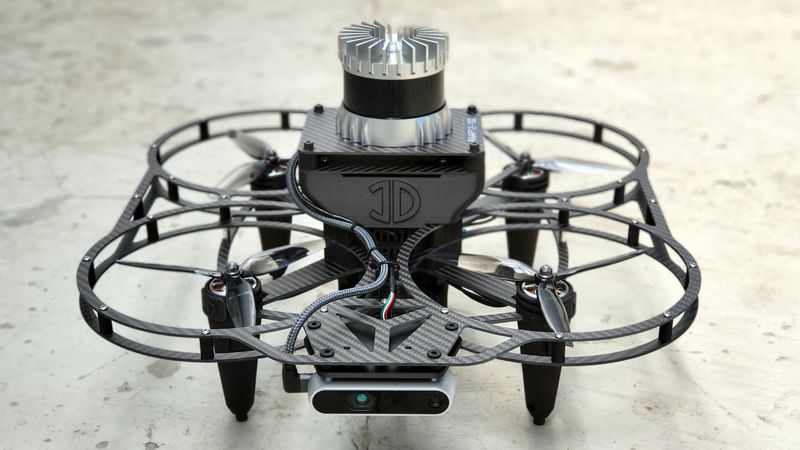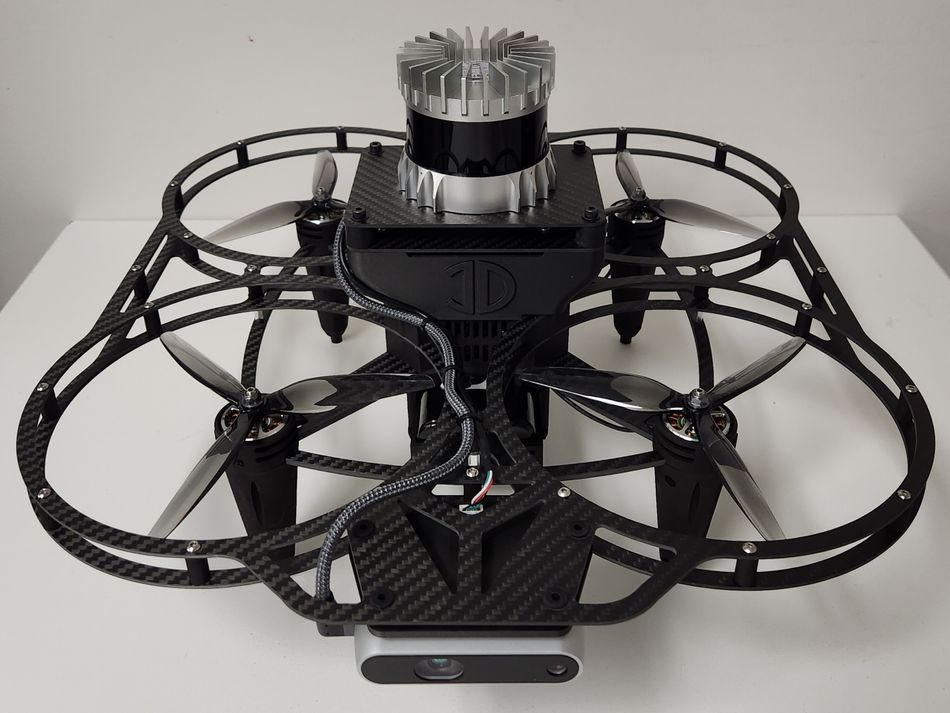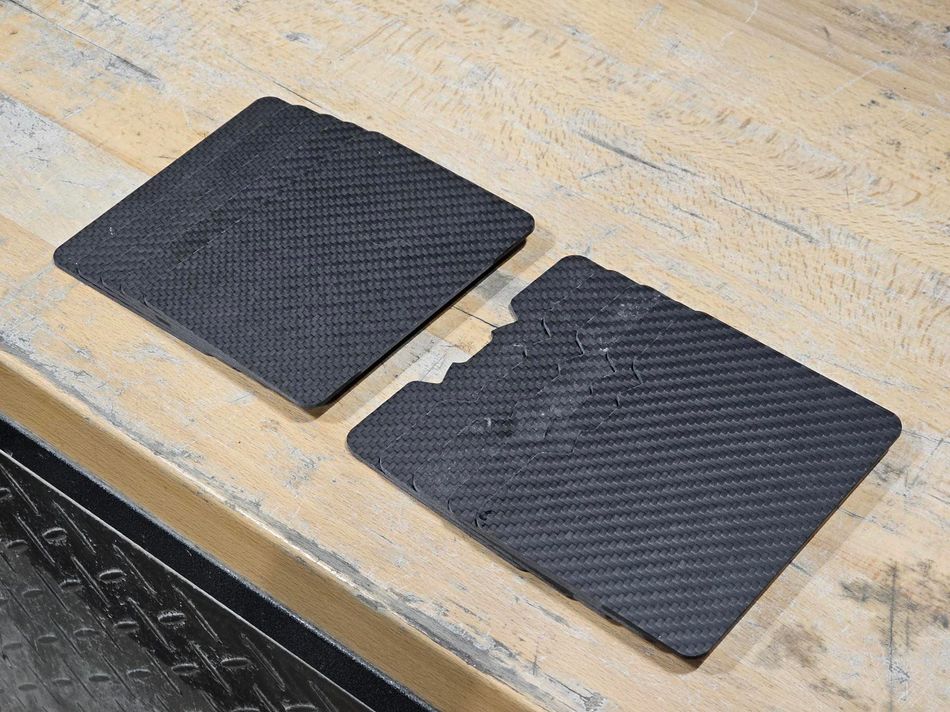Unveiling the ROS-Based Drone
An R&D Powerhouse
This article was first published on
indrorobotics.caInDro Robotics is pleased to unveil details of its highly capable new R&D drone.
Running the Robot Operating System (ROS) and with powerful onboard compute capabilities, the drone is perfect for advanced Research and Development.
“It’s a drone geared toward R&D first and foremost,” explains Luke Corbeth, Head of R&D Sales. “It truly is a flying robot – and you can program and use it in a very similar fashion to all our other robots.”
There’s a real demand in the research world for open-source drones that can be programmed and run highly complex algorithms. These kinds of drones can be used to study swarm behaviour, object detection and identification, mapping in GPS-denied locations and much more.
For some researchers, the budget go-to has been the Crazyflie, a micro-drone that uses a Raspberry Pi for compute. Its advantage is that it’s quite affordable. But its low cost, 27 gram weight and relatively low computing power means it has limitations – including the ability add sensors of any weight.
“This drone can do so much more,” says Corbeth. “With the NVIDIA Xavier NX onboard for compute, it can effectively map entire environments. And when it comes to landing and object recognition, it’s truly phenomenal. It can even land on a moving vehicle.”
Below: A look at InDro’s new drone, which comes complete with LiDAR, a depth-perception camera, 5G connectivity – and much more.
The Back Story
If you’ve been following the latest news from InDro, you’ll be aware we have an incubation agreement with Cypher Robotics. That company builds solutions for cycle counting and precision scanning in the industrial/supply chain space. InDro assisted with the development of its signature product, Captis.
Captis integrates an autonomous ground robot with a tethered drone. As the Captis robot autonomously navigates even narrow stock aisles, the drone ascends from a tether attached to that ground robot. The drone then scans the barcodes (it’s code-agnostic) of the products on the shelves. All of that data is transferred seamlessly, in real-time, to the client’s Warehouse Management System (WMS), WCS (Warehouse Control System) and WES (Warehouse Execution System) software.
The capabilities of Captis led to a partnership with global AI fulfilment experts GreyOrange and leading global telco innovator Ericsson. The product debuted at the recent MODEX2024 conference (one of the biggies in the automated supply chain world), where it gained a *lot* of attention.
While working on the project, it was always clear the drone – thanks to multiple modifications – would be highly suitable as a research and development tool. It’s capable of machine vision/object recognition, machine learning, and can find its way around in completely unfamiliar, GPS-denied environments.
“In fact, I have one client that’s using it for research in mines,” says Corbeth.
The Jetson Difference
NVIDIA has made quite a name for itself – and quite a profit for its shareholders – with its powerful AI-capable processors. The Jetson Xavier NX features a 6-core NVIDIA Carmel Arm®v8.2 64-bit processor running at speeds of up to 1.9 GHz. Its graphics processor unit features a 384-core NVIDIA Volta™ architecture with 48 Tensor Cores. Put it all together, and the computing power is astonishing: The Xavier NX is rated with a maximum achievable output of 21 TOPS – trillionoperations per second. (We were going to try to count, but thought it more efficient to rely on NVIDIA’s specs for this.)
The LiDAR unit currently shipping with the drone also has some flex. It’s the Ouster 32-channel OS1 (Rev6.2). With a maximum range of 200 metres (90 metres on a dark, 10 per cent target), its powerful L3 chip is capable of processing scans of up to 5.2 million points per second with 128 channels of vertical resolution (again, we didn’t count). Hostile environment? No problem. The LiDAR can operate from -40°C to 60°C and has an IP68 Ingress Protection rating.
“The OS1 is designed for all-weather environments and use in industrial automation, autonomous vehicles, mapping, smart infrastructure, and robotics,” states its manufacturer. “The OS1 offers clean, dense data across its entire field of view for accurate perception and crisp detail in industrial, automotive, robotics, and mapping applications.”
The unit uses open source ROS and C++ drivers, and comes with Ouster’s Software Development Kit. Its ability to accurately sense its environment (down to distances of 0.5 metres away), combined with the NVIDIA processor and the depth camera also allows this machine to do something pretty extraordinary: It can recognise and land on a moving platform.
“That’s a very challenging problem to solve and requires not only specific sensing but also really powerful onboard compute. This drone can do it,” explains Corbeth.
Already, word about the product has been spreading. A number of units have already been sold to academic institutions for research purposes – and the team has been hard at work building and testing for the next set of orders (as seen below).
The Forge Connection
Like all new products, the new drone required custom parts. We looked no further than InDro Forge, our rapid prototyping and limited production run facility in Ottawa.
Using state of the art additive and subtractive tools, the Forge team created custom mounts using carbon fibre and other strong but lightweight materials, while also ensuring the frame was robust enough to take on even the most challenging environments where these drones will be deployed.
“InDro Forge has been critical to the finished product,” says Corbeth. “We wanted a look, feel and quality that matches this drone’s capabilities – and InDro Forge delivered.”
InDro's Take
We’re obviously excited about the capabilities of this new drone, and we’re not alone. Interest in this product from researchers has already been significant. In fact, we’re not aware of any other drone on the market offering this combination of specific capabilities.
It was that void – in concert with our partnership with Cypher Robotics – that led to its creation.
“InDro has always placed a great emphasis on the development of innovative new products,” says CEO Philip Reece. “We build new products at the request of clients and also develop our own when we see a market opportunity. In this case, the requirements for Cypher Robotics dovetailed nicely with demand for such a drone from researchers.”
Production of the new drone is moving at a swift pace. If you’re interested in a briefing or demo, you can contact us here.



